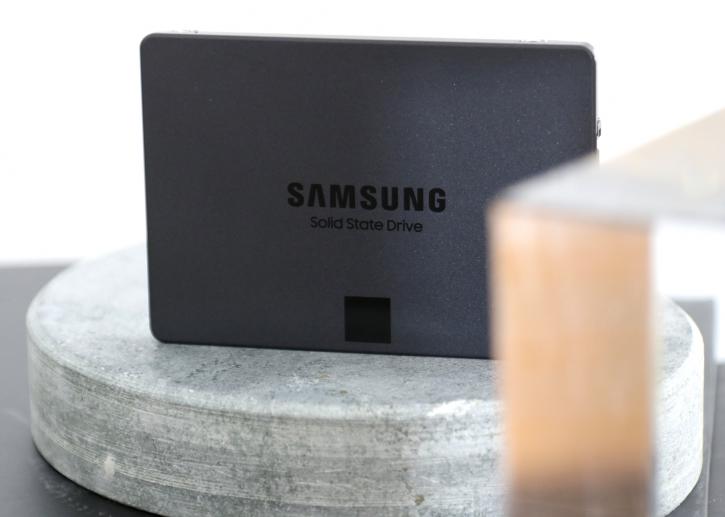Introduction
The Samsung 870 QVO SSD (2TB)
A new QLC mainstream SSDs at a value price
Samsung figures, it's time for a rehash in the QVO product lineup, and as such we'll review the Samsung 870 QVO 2TB. The product series now will become available starting at 1TB, then there is a 2TB and 4TB version, as well as an ... 8TB model! The SATA 6 Gb/s SSD series has that Q in the name, this has QLC based NAND ergo 4-bits per cell written. Don't worry, we'll explain all about that but the bottom line is that you will see a new value product series that offers more bang for your bucks and an increase in volume sizes.
NAND flash memory (the storage memory used inside an SSD) has become cheaper thanks to the new 64-layer and 96-layer fabrication, this year we have seen a stronger move to QLC NAND as well. MLC writes 2 bits per cell, TLC 3 bits per cell and QLC four bits per cell. You can see both the complication and advantage here, you can store more data in the NAND cells, increasing volume sizes. But you can also see a performance hit with an increasing write bottleneck (which you can buffer with SLC cached, DRAM or Host Memory Buffer on NVMe). For QLC based technology, endurance is also a factor, there should be less of it however with modern age wear and care technologies it still is not an issue as the TBW values are pretty terrific at 720TBW for our tested 2 TB model. The 870 QVO makes use of revision MKX of Samsungs proprietary controller, DRAM, and features like TurboWrite (SLC cache) to offer proper performance for real-world computing experiences than that of HDDs and even reached the level of current TLC SSDs. It will be an SSD series targeted towards (gaming) laptops and entry-level up-to high-end PCs. The MSRP prices in USD are $129,- for the 1TB model, $249 US for 2 TB, 4TB costs 499 USD, and the 8TB version is listed at 899 USD. These are msrp pricess though, not retail street prices. This SSD series offers peak read performance of up to 560 MB/s and a peak write speeds up to 530 MB/s. That is on all volume sizes.
96-cell layer QLC V-NAND
Apparently Samsung does not want to name their number of NAND layers as they refer to it as 9x Layer. As you guys know, we've been testing NAND Flash-based storage ever since the very beginning, and it is surprising to see where we have gotten. The SSD market is fierce and crowded though. While the stability and safety of your data have become a number one priority for the manufacturers, the technology keeps advancing at a fast pace, as it does the performance numbers a good SSD offers these days are simply breathtaking. For SATA3 you get roughly 500 MB/sec on SATA3 which is the norm for a single controller based SSD. Next to that, over the past year, NAND flash memory (the storage memory used inside an SSD) has become much cheaper as well. Prices a couple of years ago settled at just under 1 USD per GB. That was two to threefold three years ago. These days a good SSD can be found under 15 cents per GB. With parties like Samsung, Sandisk, Kioxia and Micron the prices have now dropped towards and below the 12 cents per GB marker for the cheaper SSDs. This means that SSD technology and NAND storage have gone mainstream and, due to the lower prices, the volume sizes go up as well. A year or five ago a 128 GB SSD was hot stuff, then slowly we moved to 250 GB for an SSD as the norm, this year we'll transition from 500 GB per SSD towards 1 TB as the norm for a proper Gaming / DiY PC. With the market being so huge, fierce and competitive, it brought us to where we are today, nice volume SSDs at acceptable prices with very fast performance. Not one test system in my lab has an HDD, everything runs on SSD while I receive and retrieve my bigger chunks of data from a NAS server here in the office. The benefits are performance, speed, low power consumption, and no noise.
Samsung's QVO, EVO and Pro SSD product line are powered by the company’s latest iteration NAND controller, now at revision MKX. A controller with a low power design, this drive will be amongst a fast SATA3 model, no matter what the workload is. It’s not just about performance though, it is about endurance as well. In a nutshell, endurance is the number of program-erase cycles an SSD has before you can't write onto it anymore, our tested 2 TB model can manage 720 TB of writes before cells die off, you may halve or multiply that that by volume size. That means the 1TB can manage 360 TB of writes. IOPS numbers are reaching the familiar 90,000 marker. Overall, the 860 series performance is maxed out at whatever your SATA3 interface can handle. Sequential reads performance wise are 550 MB/s and write performance is set at 520 MB/s (sequential writes). Samsung guarantees the 1000 GB 860 QVO for 3 years or the TBW value, we'll list that on the following pages though. Have a peek at the more budget-friendly SSD, after which we'll dive into a rather in-depth review.


